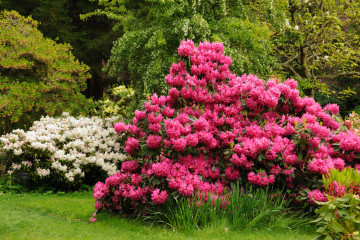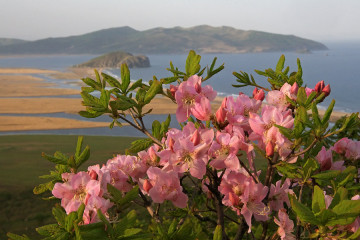Rhododendron Roseum Elegans
Content:
Rhododendron Roseum Elegans is the most common species for areas with cold winters. This hybrid is successful due to its high resistance to temperatures from -27 ° C to 30 ° C. Of course, the decorative effect of the bush adds to the popularity of this variety, since the bush is tall and spreading. The bunches of flowers are large and dense, and the buds themselves are large, wide with wavy edges.
Description
A magnificent shrub arose thanks to the English breeder E. Vaterer in the distant 50s. 19th century Hybrid Rhododendron Elegans was derived from the Katevbin variety. Its closest cousin, obtained from the same variety, is English Roseum, the pale pink bells of this species are also very resistant to weather.
Description of the variety Roseum Elegance:
- Rhododendron Roseum Elegance is an evergreen, tall and spreading shrub. It grows in height up to 3 m. The crown, up to 4 m in diameter, has a broadly rounded shape, closed from below;
- the bark is dark green, over time, the shoots are covered with a dense tree-like layer;
- dense leathery leaves 7-8 cm long have an elliptical shape. Young, only blossoming leaves of brown-red color, eventually change color to dark green;
- flowers 7 cm in diameter, five-petal curly at the edges. The color of the inflorescences is pink, juicy, on the upper petal there is a spot of orange and red dots. Pink-purple stamens are beautifully twisted at the ends, complementing the composition with white notes of their tips;
- bloom begins in June and lasts three weeks.

Round bunches of 15-20 flowers are tightly collected, they look spectacular on the dark greenery of the shrub
A unique difference from other varieties of this species is the ability of the leaves to change their color. Young leaves are red-brown, eventually turn dark green. Roseum is also distinguished by its winter hardiness and longevity; in comfortable conditions, the shrub lives up to 50 years.
In landscape design
In the garden, almost all types of rhododendrons are combined with conifers. A huge advantage of such a neighborhood is the protection of the bushes from the wind, which the variety does not like. Against the background of a hedge made of thuja or decorative undersized fir trees, Roseum Elegance looks great in solo performance.
It goes well with contrasting flowers, as well as pink shrubs of different shades. Will look great with the following varieties:
- pink University, Science Fiction, Yakushimansky, Adams and the most tender Ledebour;
- contrasting combinations will be with yellow, golden, Rasputin or Helinka.
The love of partial shade allows you to create garden compositions under the trees, planting ground cover crops nearby, creating green or flowering carpets. Rhododendrons look great along paths and hedges. They can fill the entire corner area of the garden with their spreading branches.
Planting and leaving
Hybrid rhododendron Roseum Elegans is very picky about the composition of the soil, lighting and irrigation regime.
Landing
Planting begins with the preparation of soil mixture for blooming exotic plants. The soil must be loose, light, not retain moisture and not settle. At the same time, it should contain a maximum of nutrients (but not mineral composition). The soil, which will promote active growth and flowering, must be slightly acidic.
Composition of soil for Roseum Elegance in equal parts:
- leafy land;
- sour high-moor peat;
- fallen needles;
- pine or spruce bark (crushed and partially decomposed);
- sand.
After soil preparation:
- A hole should be dug up to 70 cm deep.
- At the bottom, lay out a thick drainage layer of broken brick or large expanded clay.
- Cover the drainage layer with soil mixture and sprinkle with water or fertilizer.
- Make a small hill of earth and place a seedling on it.
- The roots must be straightened in the direction of growth.
- Sprinkle with the remaining earth carefully, without damaging the roots. Squeeze the soil.
- The root collar should protrude 2-3 cm from the ground.
- A deepening is made around the seedling for watering, and inside the soil is necessarily mulched with pine bark, needles or peat.
Care
For growth and flowering, the following conditions must be taken into account:
- the temperature range for comfortable growth is from -15 ° C to 20 ° C. The frost resistance of the shrub is up to 27 ° C, it can also withstand summer heat up to 30 ° C;
- spraying the bush is best done in the evening after a hot day. For these purposes, a regular garden hose will do;
- water in summer is a constant companion of flowering shrubs. Watering is needed abundant. On average, for an adult specimen, the rate of one watering will be 3-5 buckets of water. During the autumn cold snap, watering is minimized so as not to overcool the surface roots of the bush;
- as a top dressing, organic matter and mineral fertilizers are needed, which should be applied alternately every two weeks during the period of flowering and active growth. Any alkaline substances are contraindicated for the soil (soapy water, alkali, ash, etc.);
- spring pruning serves as a sanitary one, it is necessary to remove all damaged branches after wintering, and also to form the crown of the future bush. In the summer after flowering, it is necessary to cut off all wilted inflorescences. In the fall, the shrub is prepared for wintering by removing too long shoots, as well as branches thickening the bush.
Preparing for winter
It is necessary to protect the ends of the branches from frost. To do this, use lutrasil or spandum. Covering materials will be protection from the first bright rays of the spring sun. To protect the roots from freezing rains, it is better to mulch the soil.
Diseases and pests
Bushes rarely get sick, as breeders cherish and groom their favorites. Rhododendron gets health problems after the wrong approach in the conditions of detention. Most often this is the development of fungal diseases associated with excessive watering or overestimated acidity of the soil.
Of the pests on the bush, you can find spider mites, bugs and mealy worms. The parasites are removed with an insecticide. But slugs and snails, so fond of wet places, will have to be removed by hand.
Prevention of various problems
In order not to spoil the healthy look of the bush, it is important to remember:
- direct sunlight throughout the day will leave burns on the leaves and provoke fungal diseases of the leaf plates;
- if the care is fully consistent, and the bush does not want to bloom, he does not like the place in which it grows;
- as a prophylaxis for various diseases of the shrub, fungicidal agents are used in early spring.
Elegant pink rhododendron is an excellent solution for decorating a garden or area in front of the house. In terms of the beauty of flowering, these exotics have no equal, their magnificent bushes are capable of overshadowing any flowering plant against their background.He truly deserves his title - the king of the garden.





















